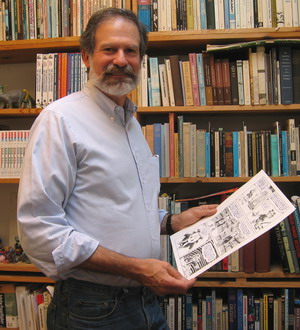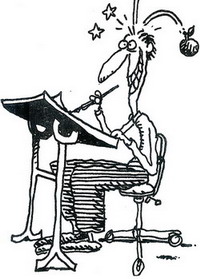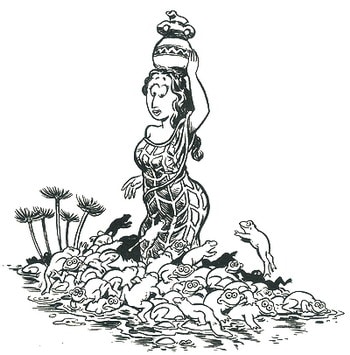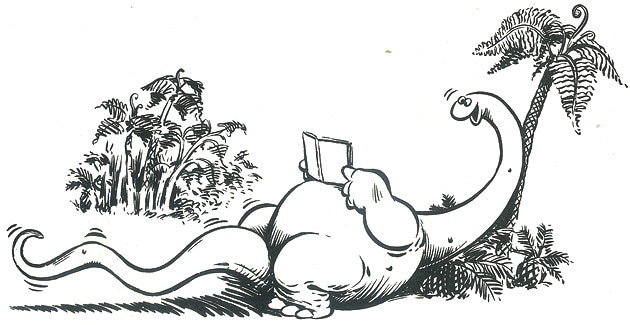
Larry Gonick, the great American cartoonist, has been an inspiration for a whole generation of geeks, reared on his series of cartoon guides to science. Talk to any Geek and they go misty-eyed over The ‘Cartoon History of the Universe’, or ‘The Cartoon Guide to the Computer’. Few schools are without their well-thumbed Cartoon Guides to Chemistry, Statistics, Physics, Modern History, Genetics, the Environment or Sex. He is one of the greatest living comic-book writers, and surely the greatest writer of cartoon text books!
Larry has been creating comics that explain history, science, and other big subjects for more than thirty years. In a cruel blow against life and the universe his first was called ‘Blood from a Stone: A Cartoon Guide to Tax Reform’ in 1971.
However, don’t let the title put you off. He confesses in this interview that he did the book as a challenge ‘a mission to bring people the information they need to make wise decisions about the future of the human community. I’m only trying to save the world here!’

Larry’s self portrait, depicting the huge amount
of research undertaken for the Cartoon history
of the Universe
He has gone on to create such masterpieces as ‘The Cartoon History of the Universe’, a pictorial history of the world in comic book form which he has been publishing in installments since 1977. He is currently working on the fifth volume. This has been a labor of love for Larry, undertaken with a phenomenal amount of research .
It was said by Terry Jones (Monty Python) to be ‘obviously one of the great books of all time.’ Never one to be trumped by a fellow actor, Steve Martin called it ‘an amazing example of the results of over-ambition: a masterpiece!’ Even Richard Gere joined in and called it ‘a wonderfully goofball vision. Serious madness for the whole human family.’ Carl Sagan described the book as ‘A Delight’

Larry, writing the Cartoon guide
to Physics.
When not being lionized by Hollywood, Larry has found time to write ‘The Cartoon History of the United States‘, and he has adapted the format for a series of co-written guidebooks on other subjects, beginning with ‘The Cartoon Guide to Genetics’ in 1983 and the ‘Cartoon Guide to Computer Science’ (later the Cartoon Guide to Computers) the following year.
From 1990 to 1997, Gonick penned a bimonthly ‘Science Classics’ cartoon for the science magazine Discover. Each two-part comic discussed a recent scientific development, often one in interdisciplinary research. Because of his concern about the shameless expropriation of public space, public enterprise, and the environment Larry did a series of cartoons called ‘The Commoners’ originally published by OntheCommons.org.

An Egyptian contemplates the effects of a
couple of Jehovah’s plagues
The diversity of his interests, and the success with which his books have met, have together earned Larry the distinction of being awarded the Ink-Pot award, something which is given annually by Comic-Con International to professionals in comic book, comic strip, animation, science fiction and pop-culture. Other luminaries to receive the award have included the film-maker Frank Capra, Edgar Rice-Burroughs and Steven Spielberg. He was elected by his peers to receive the 2003 Harvey Award given to Cartoon History III as “best graphic album of original work.” In the comics world, this is the equivalent of an Oscar
Larry has been a Knight Science Journalism Fellow at MIT and is currently staff cartoonist for Muse magazine. He has nearly one million copies of the Cartoon Guides in print.
Larry studied Maths at Harvard, and lived for a while in Arizona, Massachusetts, India, before finally settling in California. He lives in San Francisco with his wife and two daughters.
- RM:
- “Larry, you’re probably best known for the immensely ambitious ‘The Cartoon History of the Universe‘ but the ‘Cartoon Guide to the Computer‘ is a great read and is fun introduction to the computer, which is quite something given it covers from logic (gate) design up through floating point and (Shannon) communication theory. I know that perceived fun in science nettles some people but do you think it’s important to present science as fun?”
- LG:
- “I don’t really know if it’s ‘important’ to present science as fun. A science teacher might get better results by whacking students with a spiked club wrapped in nettles whenever they make a mistake. In fact, I understand that may be how it’s done in some countries with higher test scores than we have here. But I prefer to have fun with it. Why not? There are, in fact, some pedagogical advantages to humour: humour that arises naturally out of the subject helps reinforce or underscore important points. In the writing, I often find humour when I think most deeply about my material, and hidden connections or ideas appear.
If I find myself adding extraneous humour like salad dressing, then I know I’m doing something wrong. I hope this pays off for my readers. At least they aren’t always cringing and looking over their shoulders and clutching tubes of aloe vera. It gives a guy a good feeling knowing that.”
- RM:
- “When your ‘Cartoon Guide to the Computer‘ book first came out in 1983 it was called ‘The Cartoon Guide to Computer Science‘. So much has happened in the world of computers since then, do you think that there’s a chance of it being updated? “
- LG:
- “Not by me! No time! I decided long ago not to take on any more subjects that are in process of rapid change. Neuroscience would be another example.”
- RM:
- “How did you do the research for the book and why did you decide to convey information in comic book form?”
- LG:
- “The computer book was an exception to my other Cartoon Guides. The rest of them are collaborations with scientists, who provide expertise, structure, and indeed a manuscript. The problem with computers, at least back in the 1980s when the book was written, was that everyone in the field was too busy inventing the next Big Thing to waste time writing a cartoon guide. The best I could get from my preferred collaborator, a programmer named Jay Hosler, was consultation. He pointed me in some direction and I read some books and learned a little BASIC programming. I daresay the book might have been improved with more of his participation. As it was, I still really thought of computers as glorified calculators.
Why convey information in comic books? It’s an idea that’s fascinated me ever since I saw ‘The Amazing Story of Measurement’ as a child.”
- RM:
- “Ha, ‘The Amazing Story of Measurement’. Was the innocent little comic part of a Euro-plot to foist the metric system on the unsuspecting youth of America, do you think?”
- LG:
- “It was a commercial comic put out by the Lufkin Rule Co. in the 1950s to sell micrometers and such. Somehow they stumbled onto a writer who put real wit into it. Other than that, I know nothing about it. Even the metric system was described drolly, with the story that French egg-sellers with the temerity to continue selling by the dozen risked jail or the stocks.”
- RM:
- “Is it true someone once approached you to draw a comic book about taxation? How did that come about?”
- LG:
- “It is true. This was my first “educational comic,” done while I was still in grad school (in math) back in the ’70s. It came about when a friend broached the project. He had seen political-education comics in Latin America and wanted to try out the genre in English. He had written a script on taxation, the dullest subject he could think of. We did it, and it opened up this idea of using the medium for what promised be a lifetime’s worth of material. It’s a wonderful way to marry fact and interpretation, information and commentary. I’m now convinced that some of its illustrative techniques are arguably the best way to present certain areas of knowledge.”
- RM:
- “Do you think non-geeks should bother to learn about the history of the computer?”
- LG:
- “Let’s just say I think it’s an interesting subject, and it’s probably a good idea for anyone who fancies him or herself an educated person to understand the basic thrust of such an important part of the modern landscape.”
- RM:
- “What motivated you to write the book in the first place and have ever thought what the ‘Cartoon History of Microsoft’ might look like?”
- LG:
- “It was a hot subject! Ride the wave! Make big sales! Little did I realize how fast it was advancing, and how rapidly books about computers became obsolete. Here at least I was lucky: my concentration on logic and the essential ideas behind computation meant that the book contained a large kernel of still-relevant material.
Microsoft… Microsoft… I think I’ve heard of them…”
- RM:
- “I read somewhere that your first computer was an Atari, which ran off a 13-inch TV screen. What did you use it for and have things changed since then or do you still use the little beast?”
- LG:
- “Wow, you’ve done your research! I used it for word processing only. The software was on an insertable cartridge. Two external floppy drives. Now I use a Mac. It lets me do word processing AND browse the web. AND do email. Wow! I still draw by hand, pen and ink or brush and ink, but a lot of my process has migrated into the box. Everything is scanned now and touched up in PhotoShop, my “hand lettering” is a homemade font, pages are assembled in InDesign, and color is done in PhotoShop too. I just about never paint any more, which is fine with me. I love what computers can do.
The most lamentable loss for me is that there no longer has to be a page of “original art.” PhotoShop makes it so easy to collage stuff, make changes, fill in black areas, and the like, that an artist no longer has to create a perfect-looking paper page. I’ve accepted this fact for much of my work, but I’m still doing every page of the Cartoon History start to finish on paper.”
- RM:
- “The blurb about your tremendously invigorating The Cartoon Guide to Sex says it takes you from and I quote:
‘the first eye contact to the therapist’s couch, from the throes of ecstasy to the nitty-gritty of safer sex, from the world’s sexiest animal to the dating jungle, The Cartoon Guide to Sex covers everything you’ve always wanted to know about sex. Frank, informative, and written with Larry Gonick’s characteristic comic verve and scientific accuracy, this book gives a comprehensive discussion of the spectrum of human sexuality, including sexual structures and functions, gender roles and sexual identity, sexual arousal and response, sexual communication, love, marriage and other arrangements, contraception, and sexual health – without the fig leaves.’
- Have you ever thought about trying to turn this into a movie? If so, who would you cast in the main roles such as the brontosaurs necking?”
- LG:
- “A movie? Now there’s an idea. If we cast brontosauri, they would probably have to be animated. Though not very.”
- RM:
- “Have you ever thought of a subject for a time then given up on it because you either thought a publisher wouldn’t commission the idea or it was just too ridiculous?”
- LG:
- “Once upon a time, all my ideas seemed too far-fetched. Once I got published and established relationships with my publishers, though, the conversation about subject matter has always been friendly. The publisher’s main consideration (surprise?) has been market size, so in the sciences they prefer subjects with large course enrolment. Hence general physics, not relativity. Statistics, not statistical mechanics.
- RM:
- “What has been your worst experience with a book publisher because it’s a funny old business isn’t it?”
- LG:
- “It’s a funny business, and I’m afraid the worst experience will have to remain my business; the wounds are still too raw. I have had a couple of very good experiences, though. Maybe we’ll talk about them another time.”
- RM:
- “One final question to wrap this interview up Larry. I think I’ll give you a plug. What would you say is the best introduction to your work?”
- LG:
- “‘The Cartoon History of the Universe’ I, I guess. Or people can go to my web site www.larrygonick.com and poke around.
You will find a list of Larry’s books here
The Commoners Comic Strip here
and The Raw Material site here




Load comments